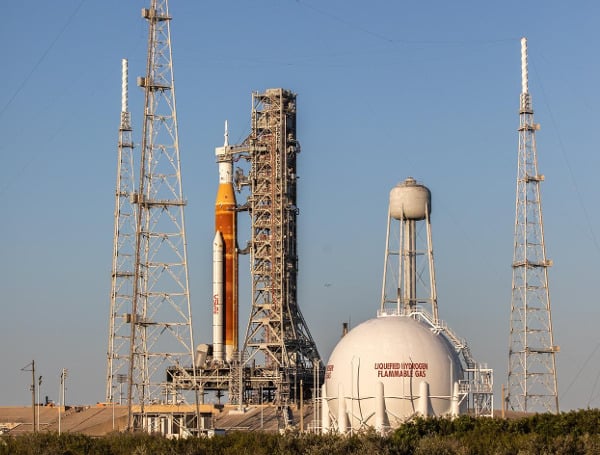
Credits: NASA/Ben Smegelsky
NASA confirmed it remains on track for the launch of the Artemis I Moon mission during a two-hour launch window that opens at 1:04 a.m. EST on Wednesday, Nov. 16.
The launch countdown will begin at 1:24 a.m. on Monday, Nov. 14.
Artemis I is the first integrated flight test of NASA’s Space Launch System (SLS) rocket, an uncrewed Orion spacecraft, and the ground systems at the agency’s Kennedy Space Center in Florida. The mission will pave the way for a crewed test flight and future human lunar exploration as part of Artemis.
Following Hurricane Nicole, teams have conducted thorough assessments of the rocket, spacecraft, and associated ground systems and confirmed there were no significant impacts from the severe weather. The SLS rocket and Orion spacecraft arrived at Kennedy’s Launch Pad 39B on Nov. 4 and rode out the storm there.
Live coverage of briefings and events will air on NASA Television, the NASA app, and here on The Free Press:
Engineers previously rolled the rocket back to the Vehicle Assembly Building (VAB) Sept. 26 ahead of Hurricane Ian and after waving off two previous launch attempts Aug. 29 due to a faulty temperature sensor, and Sept. 4 due to a liquid hydrogen leak at an interface between the rocket and mobile launcher. Prior to rolling back to the VAB, teams successfully repaired the leak and demonstrated updated tanking procedures. While in the VAB, teams performed standard maintenance to repair minor damage to the foam and cork on the thermal protection system and recharge or replace batteries throughout the system.
A limited number of seats inside Kennedy’s Press Site auditorium will be available during NASA TV briefings to previously credentialed on-site journalists on a first-come, first-served basis. The deadline has passed for media accreditation for in-person coverage of this launch.
To participate by telephone, media must RSVP no later than two hours before the start of each briefing to: ksc-newsroom@mail.nasa.gov.
Media and members of the public may also ask questions on social media using #Artemis. Audio only of the briefings will be carried on the NASA “V” circuits, which may be accessed by dialing 321-867-1220, -1240 or -7135.
NASA’s media accreditation policy for virtual and on-site activities is available online. More information about media accreditation at Kennedy is available by emailing: ksc-media-accreditat@mail.nasa.gov.
Full launch coverage is as follows. All times are Eastern, and the information is subject to change. Follow NASA’s Artemis blog for updates.
Sunday, Nov. 13
7 p.m.: NASA will hold a prelaunch media teleconference following a mission management team meeting with the following participants:
- Bill Nelson, NASA administrator
- Mike Sarafin, Artemis mission manager, NASA Headquarters
- Charlie Blackwell-Thompson, Artemis launch director, Exploration Ground Systems Program, Kennedy
- Emily Nelson, chief flight director, NASA Johnson
- Melody Lovin, weather officer, U.S. Space Launch Delta 45
Monday, Nov. 14
12 p.m.: NASA will hold a prelaunch media briefing on NASA TV to provide a status on the launch countdown with the following participants:
- Jeremy Parsons, Exploration Ground Systems Program deputy manager, NASA Kennedy
- Melody Lovin, weather officer, U.S. Space Launch Delta 45
Tuesday, Nov. 15
3:30 p.m.: NASA TV commentary coverage of tanking operations to load propellant into the SLS rocket begins, including views of the rocket and Launch Control Center, and audio from a commentator.
10:30 p.m.: NASA TV commentary coverage of launch begins in English. Coverage will continue through translunar injection and spacecraft separation, setting Orion on its path to the Moon.
Wednesday, Nov. 16
12 a.m.: NASA TV commentary coverage of launch begins in Spanish on NASA’s Spanish-language YouTube account and will continue approximately 15 minutes after liftoff. Mission coverage updates will be posted on the NASA en español social media channels.
4 a.m.: NASA TV coverage of the postlaunch news conference will follow approximately one hour after the live launch broadcast ends. Coverage start time is subject to change, based on the exact liftoff time. The postlaunch news conference will include the following participants:
- Bill Nelson, NASA administrator
- Mike Sarafin, Artemis mission manager, NASA Headquarters
- Mike Bolger, Exploration Ground Systems Program manager, Kennedy
- John Honeycutt, Space Launch System Program manager, Marshall
- Howard Hu, Orion Program manager, NASA’s Johnson Space Center
- Emily Nelson, chief flight director, Johnson
8:30 a.m.: NASA TV commentary coverage of Orion’s first outbound trajectory burn on the way to the Moon. Coverage start time is subject to change, based on the exact liftoff time.
10 a.m.: NASA TV commentary coverage of first Earth views from Orion during outbound coast to the Moon.
Live NASA TV coverage leading to launch will begin with commentary of tanking operations at 3:30 p.m. Tuesday, Nov. 15, followed by launch coverage beginning at 10:30 p.m.
Visit Tampafp.com for Politics, Sports, and National Headlines. Support journalism by clicking here to our GiveSendGo or sign up for our free newsletter by clicking here.
Android Users, Click Here To Download The Free Press App And Never Miss A Story. Follow Us On Facebook Here Or Twitter Here.
